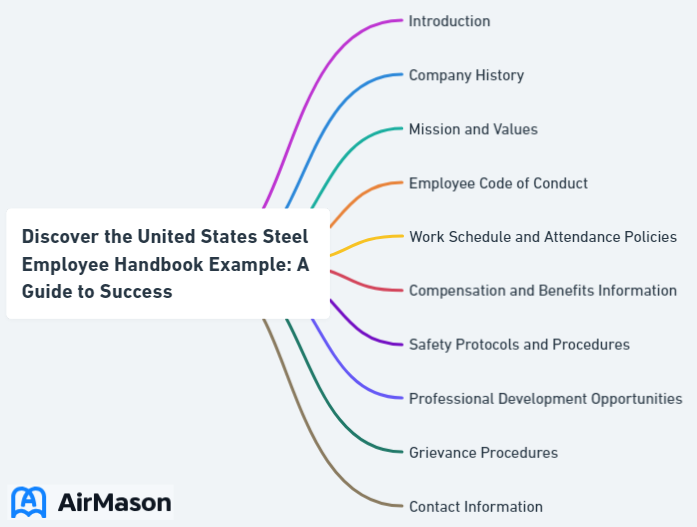
Imagine working for a company with a strong commitment to its employees, providing them with a comprehensive guide to success, and actively participating in creating a more sustainable future. Welcome to the world of the United States Steel Corporation! In this blog post, you’ll learn about their United States Steel employee handbook example, training programs, and sustainability efforts, all geared towards ensuring success in the steel industry.
Key Takeaways
- The United States Steel Employee Handbook serves as a reference guide to promote employee success.
- Senior management plays an important role in setting goals and providing resources for employees.
- US Steel Corporation has implemented environmental policies, initiatives, and programs to reduce emissions and conserve energy.
Employee Handbook Example
In this comprehensive employee handbook example, we outline the essential guidelines and policies that govern our workplace. The employee handbook example serves as a valuable resource for our team, offering clear insights into our company culture, expectations, and the various benefits and responsibilities that come with being a part of our organization. It is designed to provide employees with a thorough understanding of our values, code of conduct, and the procedures they should follow to ensure a productive and harmonious work environment. This employee handbook example aims to be a reference point for both new hires and existing team members, fostering a transparent and collaborative atmosphere within our company.
Understanding the United States Steel Employee Handbook
The United States Steel Corporation, a leading steel producer, is known for providing services to various industries such as:
- Automotive
- Construction
- Appliance
- Energy
- Containers
- Packaging
With its progressive, inclusive, and comprehensive benefits, the company empowers employees by offering them the resources and support needed to succeed. The United States Steel Employee Handbook serves as an important guide to help employees navigate their career journey within the company.
The handbook serves as a comprehensive guide, covering essential aspects such as company policies, standards of conduct, and expectations for workplace behavior. Aligning with the company’s S.T.E.E.L. Principles and Best for All(SM) strategy, it aims to create a more sustainable future for all stakeholders, including the planet. We will now discuss the purpose of this handbook and its key sections in more detail.

Purpose of the Handbook
The United States Steel Employee Handbook is instrumental in guiding employees throughout their career path within the company. It provides a clear overview of company policies, rights, responsibilities, and values. The handbook is designed to clarify the company’s expectations for behavior in line with the S.T.E.E.L. Principles, ensuring that employees understand their roles and responsibilities within the organization.
Beyond serving as a key reference guide, the handbook promotes employee success by detailing guidelines on:
- Integrity
- Ethical conduct
- Workplace conduct and safety training
- Adherence to labor and employment laws
By adhering to the guidelines, employees can cultivate an ethical environment, guarantee transparency, and encourage accountability and respect within the company.
Key Sections
The United States Steel Employee Handbook comprises several key components, including:
- The Code of Ethical Business Conduct
- The Ethics and Compliance Program
- The Agreement between United States Steel Corporation and the United Steel, Paper and Forestry, Rubber, Manufacturing Union
- The Pension Benefit Program for executives and key managers
Each section plays a pivotal role in providing employees with a clear understanding of the company’s expectations and guidelines.
For instance, the United States Steel Employee Handbook includes the following key sections:
- Code of Ethics: Outlines guidelines and principles applicable to all employees, directors, and officers of the company. It assists employees in making ethical decisions and encourages reporting possible violations of law.
- Safety Policy: Emphasizes the importance of safety and minimizing occupational health risks. The company’s primary core value is ‘Safety First’.
- Roadmap to Success: The handbook serves as a roadmap to success for its employees, providing guidance and information on various aspects of the company’s operations.
The Role of Senior Management in Employee Success
Senior management significantly contributes to employee success at the United States Steel Corporation. They do this by:
- Establishing a clear vision and direction for the organization
- Providing employees with the necessary resources and support
- Cultivating an environment of trust and respect
The CEO, for instance, provides a role model for the company values and establishes a clear direction for employees to emulate.
In fact, United States Steel’s leadership strategy focuses on:
- Achieving success in strategic markets
- Enhancing capabilities in their most advantageous areas to better serve their customers
- Prioritizing business transformation
- Having leaders who are responsible for strategic and financial matters
We will now examine the leadership strategy and the company’s initiatives to foster a diverse and inclusive culture.
Leadership Strategy
At the heart of United States Steel Corporation’s leadership strategy is the development of capabilities in strategic markets and being customer-centric. The leadership team, consisting of key leaders like:
- David B. Burritt
- Daniel R. Brown
- James E. Bruno
- Scott D. Buckiso
- Tara Carraro
- Richard L. Fruehauf
- Christian Gianni
The Senior Vice President is accountable for driving the company’s strategic and financial matters.
Leaders at United States Steel Corporation fulfill various roles, such as:
- Executive leadership
- Overseeing operations
- Leading business transformation
- Managing procurement
- Human resources
Their leadership strategy cultivates a culture of commitment, respect, and appreciation, serving as a catalyst for employees to reach their full potential. Additionally, the company’s focus on inclusion, diversity, equity, and belonging bolsters employee success and aligns employees’ actions with the company’s objectives.
Encouraging a Diverse and Inclusive Culture
United States Steel highly values and promotes diversity and inclusion, striving to create an environment where every employee can reach their full potential and contribute to the company’s success. They have implemented diversity and inclusion programs that capitalize on a variety of perspectives and involve initiatives such as Employee Resource Groups (ERGs) that promote the professional growth of women through networking and education.
The company has also published a Diversity, Equity, and Inclusion (DEI) report, highlighting their efforts to nurture and maintain an inclusive culture. By embracing diversity and inclusion, United States Steel Corporation not only creates a better workplace for its employees but also ensures a more sustainable and successful future for the company.
Baker Hughes Employee Handbook Example
In the Baker Hughes employee handbook example, employees gain access to a comprehensive guide outlining the company’s policies, procedures, and expectations. The Baker Hughes employee handbook example serves as a valuable resource, offering insights into workplace culture, code of conduct, and benefits. This document ensures that employees are well-informed about the company’s values and guidelines, fostering a positive work environment. By referring to the Baker Hughes employee handbook example, both new hires and existing staff can navigate their roles with clarity, understanding the organization’s commitment to professionalism and mutual success
Tools and Equipment for Ironworkers
Ironworkers, responsible for the installation of structural and reinforcing iron and steel in the creation and maintenance of buildings, bridges, and roads, hold a significant role in the steel industry. To perform their duties, ironworkers need a variety of tools and equipment, which are essential for their day-to-day work.
In this part of the article, we will cover the construction tools and materials, along with the safety equipment and protocols necessary for ironworkers to excel in their roles.
Construction Tools and Materials
Ironworkers employed by the United States Steel Corporation require a range of tools, including:
- Diagonal Cutting Pliers
- Rebar Bender
- Spud Wrench
- Bolt Cutter
- Chipping Hammer
- Welding Machine
- Tape Measure
- Level
- Hammer
- Safety Harness
- Lanyard
These tools are essential for performing various tasks in ironworking, ensuring a strong connection between different components.
The materials commonly employed by ironworkers in the steel industry include:
- Steel
- Aluminum
- Alloy steels
- Refractory materials
These materials are utilized for fabrication, construction, and structural purposes, as well as to protect molten metal from oxidation and slag formation. With the right tools and materials, ironworkers can efficiently and effectively carry out their responsibilities.
Safety Equipment and Protocols
Safety is of paramount importance in the steel industry, and ironworkers must comply with strict safety protocols to ensure their well-being. They employ the following safety equipment:
- Protective gloves
- Safety glasses
- Hard hats
- Safety belts or harnesses
- Safety goggles
- Fall protection systems
- Machine guards
These measures are taken to guarantee their safety on the job.
It is vital for ironworkers to adhere to federal regulations and guidelines related to safety equipment, such as:
- ANSI B11.5-1975
- Fall protection equipment
- Hazard identification
- Control measures
By complying with these safety protocols, ironworkers can minimize the risk of accidents and injuries, ensuring a safe and productive working environment.
Training and Development Programs for Steel Employees
To excel in their roles, steel employees require training and development programs that provide them the necessary skills and knowledge. These programs can include:
- Apprenticeships
- On-the-job training
- Continuing education
- Certifications
All designed to help employees succeed in the steel industry by utilizing an efficient system.
In this part of the article, we will cover various training and development programs available for steel employees, and discuss how these programs contribute to successful careers.
Apprenticeships and On-the-Job Training
Apprenticeships and on-the-job training are common paths for individuals seeking to become ironworkers. These programs typically last for three to four years and include a combination of on-the-job training and technical instruction. United States Steel Corporation offers an apprenticeship program at their facilities located in Pennsylvania, Ohio, and West Virginia.
The on-the-job training process at US Steel Corporation combines skill-building and practical experience. The Management Associate Program offers on-the-job training to new graduates, who gain proficiency by completing assignments that foster their development. By participating in these programs, steel employees can acquire the skills and competencies necessary for success in their roles.
Continuing Education and Certifications
Continuing education and certifications are essential for steel industry professionals to broaden their manufacturing processes and engineering skills, ensure the quality of their workmanship and materials, and obtain industry-recognized credentials. Numerous continuing education programs are available, such as online steel building systems education courses, workshops and sessions for professional development, webinars, and courses in metallurgy.
The mandatory certification for a career in steelwork is the AISC (American Institute of Steel Construction) Certified Fabricator, while other beneficial certifications include CRSI (Concrete Reinforcing Steel Institute) and certifications in welding. By pursuing these certifications and continuing education opportunities, steel employees can further enhance their skills and knowledge, leading to more successful careers in the industry.
Labor Statistics and Employment Outlook for Ironworkers

For anyone considering a career in this field, gaining knowledge of labor statistics and employment outlook for ironworkers is important. According to the U.S. Bureau of Labor Statistics, the median annual wage for structural iron and steel workers was $60,500 in May 2022, and the median annual wage for reinforcing iron and rebar workers was $51,070 in May 2022.
In this part of the article, we will review the Bureau of Labor Statistics data on ironworker employment, and the factors influencing job growth in the industry.
Bureau of Labor Statistics Data

The Bureau of Labor Statistics (BLS) is a government agency responsible for collecting, analyzing, and disseminating data on labor and employment in the United States. The BLS reports that Structural Iron and Steel Workers earn an hourly wage ranging from $18.22 to $38.04 with an annual wage range from $37,890 to $60,500, while Reinforcing Iron and Rebar Workers receive an hourly wage ranging from $18.42 to $30.62 and an annual wage ranging from $38,310 to $51,070.
The BLS projects a job growth rate of 2 percent for ironworkers from 2022 to 2032, with approximately 9,400 openings anticipated within this timeframe. This growth rate is comparable to the average growth rate of all occupations, indicating a stable job market for ironworkers in the coming years.
Factors Affecting Job Growth

Numerous factors can affect job growth in the steel industry, such as:
- Production costs
- International trade dynamics
- End-customer demand
- Economic growth
- Increased productivity
The economy has a direct effect on job growth, as demand for steel products, trade barriers, and overall economic growth can impact employment opportunities.
The influence of automation technology on job growth for ironworkers is a double-edged sword. On one hand, automation can improve productivity and efficiency, potentially resulting in higher demand for ironworkers. Conversely, automation can also cause job displacement as certain tasks become automated. Factors such as the rate of technological adoption and the capacity of workers to adjust to new technologies will ultimately determine the effect of automation on job growth for ironworkers.
United States Steel Corporation’s Commitment to Sustainability

The United States Steel Corporation shows a robust commitment to sustainability and environmental stewardship, placing a high priority on environmental responsibility as one of their fundamental principles. The company has set ambitious goals to achieve net-zero greenhouse gas emissions by 2050 and has made progress in reducing emissions intensity. They also focus on innovative solutions and industry-leading low-carbon processes to create profitable and sustainable steel solutions while emphasizing the health and safety of their employees.
In this part of the article, we will cover the company’s environmental policies and initiatives, and how employees can participate in sustainability efforts.
Environmental Policies and Initiatives

United States Steel Corporation has implemented a range of sustainability initiatives, such as greenhouse gas reduction, a net-zero emissions goal, environmental stewardship, biodiversity conservation, participation in the ResponsibleSteel™ certification initiative, and energy conservation. These initiatives have had a notable impact, including remediation and restoration of former properties for new uses, focus on innovative and low-carbon processes, enabling of green technologies, and contribution to lowering greenhouse gas emissions.
The company has also been acknowledged for their environmental policies, receiving the ResponsibleSteel Standard award and the National Safety Council’s Green Cross for Safety Excellence Award. These recognitions highlight the company’s dedication to sustainability and environmental protection.
NextEra Energy Employee Handbook Example
NextEra Energy’s commitment to fostering a positive and inclusive work environment is exemplified in the NextEra Energy employee handbook example. This comprehensive guide outlines the company’s values, policies, and expectations, providing a valuable resource for employees to navigate their professional journey. From ethical standards to workplace protocols, the NextEra Energy employee handbook example serves as a cornerstone for creating a workplace culture that prioritizes integrity, collaboration, and personal growth. Employees can rely on this handbook to gain insights into the company’s mission, benefits, and the shared responsibility of building a sustainable and successful future together.
Employee Involvement in Sustainability Efforts
Employee involvement in sustainability efforts is crucial for the success of the company’s sustainability initiatives. Employees can participate in initiatives and programs that promote sustainability and environmental protection, such as:
- Diversity, equity, and inclusion initiatives
- Prioritizing health and safety practices
- Supporting climate strategy and energy conservation projects
- Engaging in volunteer work and community engagement activities.
United States Steel Corporation offers a range of programs and initiatives to promote employee engagement in sustainability, such as:
- The Management Associate Program
- Partnership with the United Steelworkers on safety practices
- Offering maintenance technician programs and training for contractors
By actively participating in these initiatives, employees can contribute to a more sustainable future for the company and the planet.
Summary
In conclusion, the United States Steel Corporation provides a comprehensive employee handbook, progressive policies, and a range of training and development programs to help employees succeed in the steel industry. With a strong commitment to sustainability and environmental stewardship, the company is paving the way for a better future for its employees and the planet. By understanding the intricacies of the employee handbook, the role of senior management, and the importance of training and development, individuals can excel in the steel industry and contribute to a more sustainable world.
Frequently Asked Questions
Is U.S. Steel a good company to work for?
With an overall rating of 3.6 out of 5, employees praising its benefits and salary, and the recognition by leading organizations for efforts to build a diverse, equitable and inclusive workplace, United States Steel is a good company to work for.
What is the U.S. Steel safety policy?
U.S. Steel puts safety first with a commitment to providing safe and healthy working conditions for the prevention of work-related injuries and illnesses, as well as continual improvement of their occupational health & safety management system.
Does the company U.S. Steel still exist?
Yes, U.S. Steel still exists as an independent, publicly traded corporation with an annual tubular products capacity of 1.9 million net tons.
Is U.S. Steel a union company?
U.S. Steel is a union company, as demonstrated by the existence of successorship clauses in the United Steelworkers Union’s basic labor agreement.
What is the purpose of the United States Steel Employee Handbook?
The United States Steel Employee Handbook provides employees with a guide to company policies, standards of conduct, and expectations for workplace behavior, helping them understand their roles within the organization.
Important Disclaimer:
The article presented here does not serve as a representation of the company’s actual employee handbook mentioned in this article.
Our discussions and insights regarding employee handbook are based on assumptions about what may be considered significant in this companies’ policies. These assumptions are drawn from available information and industry knowledge. Readers are advised that the content provided is for informational purposes only and should not be construed as an exact reflection of any company’s official policies or procedures. For precise and accurate details regarding a company’s employee handbook, individuals should refer directly to the company’s official documentation or consult with appropriate representatives.
Please be aware that the content on this page has been generated by using artificial intelligence language models and may contain errors, inconsistencies, or outdated information. It is provided as-is without any warranties or guarantees of accuracy. We strongly recommend using this content as a starting point for further research. We disclaim any liability for damages or losses resulting from the use or reliance on this content.